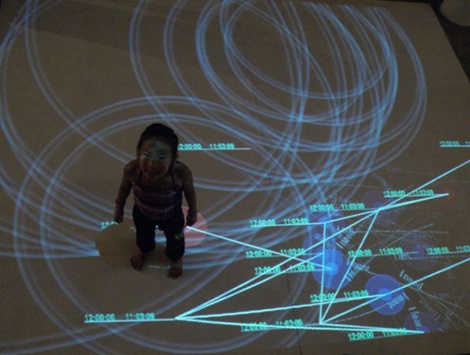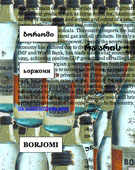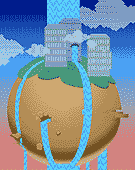HyperTerritory - Frictions of Distance is a time and space defying installation allowing people in London/UK and Phnom Penh/Cambodia, to simultaneously walk in each others footsteps.
This video was filmed from the Phnom Penh side of the installation. People produce white circles as they walk and blue (Londoners) or red (Phnom Penhners) prints as they stand still. These are replicated live on both sides.
Full Description
For humans, since always (from when we were tracking animals in the bush until Neil Armstrong’s walking on the moon), the footprint has been the proof that you were physically there. But while we are still conquering spaces, we are currently creating new ones, with new rules.
HyperTerritory - Frictions of Distance makes this obvious: walking here you leave footprints there, real time, thousand of kilometres away.
Thus, HyperTerritory - Frictions of Distance is a time and space defying installation allowing people (in its first version) in London/UK and Phnom Penh/Cambodia, to simultaneously walk in each others footsteps.
Friction of Distance
In Geography, interaction (I) between two cities is an inverse function of distance (D) amended by the population of these cities (P).
We therefore have this formula :
I = f (P1, P2, 1/D)
The actual formula being :
I = k [ (P1 x P2) / D^ß]
k is a constant to scale predictions up and down. ß is the Friction of Distance, a power to adjust the effect of distance.
It is interesting to see that if we set ß to 2, we get a very similar formula to the physicist Newton's gravity, mass, distance and force equation.
If ß is big this expresses how much distance affects interaction (because of effort, energy, cost, time... that are required), but if ß is null then (D^ß]) is equal to 1. The distance has no effect on interaction... At first, this does not seem possible, but could it be?
Space
The information age has put space at the heart of new debates. While some talk about “The End of Geography” (O’Brien, economist, futurist and author) or the “The Death of Distance" (Cairncross, economist, journalist and academic), others argue that communication technologies do actually consider space whilst redefining our relations to it (Bidou, sociologist), or explain that space is now made of various layers (Martin Jourdenais and Pierre Desrochers, sociologist): the Traditional, the Cyberspace (Gibson, cyberpunk writer) and the Space of Flows (Castells, sociologist).
The installation can be considered as a metaphor of a Space of Flow. Indeed, Castells explains that it links up distant locales around shared functions and meanings on the basis of electronic circuits and fast transportation corridors, while isolating and subduing the logic of experience embodied in the Space of Places (The Space of Places being the “Traditional Space”).He also describes it as enabling synchronistic and real-time interaction without physical proximity, a none passive space as it evolves with time. This space implies a new power model, it also generates new expression of identity (via avatars).
HyperReality - HyperTerritory
About Hyperreality, Baudrillard (cultural theorist and sociologist) describes it as simulation of a real without real origin. Borrowing from Carroll the example of a society whose cartographers create a map so detailed that it covers the very things it was designed to represent, and pushing the idea further, he argues that the territory no longer precedes the map, nor does it survive it, but that it is actually the map that precedes the territory. "HyperTerritory - Frictions of distance's" installations are (the none exclusive...) pieces of an Hyperreal territory under construction.
U-cities (pervasive cities)
For Ubiquitous cities. Songdo, the $25 billions investment project in South Korea is one of them. But actually, the presence and extensive integration of mobile phone, RFID tags, QR codes, Bluetooth, NFC... has the potential to transform any city into a ubiquitous city. In the U-city, all information systems are linked, and virtually everything is linked to an information system. For instance, if you through a can in a recycling bin, your bank account is automatically credited, thus rewarding your positive behavior towards the environment, surely it is known that the can is yours, for you have been identified throwing it away. Easy, the chip you are wearing (could be your phone or an implant) communicates with the chip on the bins, the chip on the can and your bank account. Marzloff (sociologist) sees people in cities moving around inside a personal bubble of communication.
Effective and convenient, but in terms of privacy, the pervasive city could easily be invasive like Oceania described by Orwell (SF writer) in his novel 1984... In HyperTerritory - Friction of Distance, you leave your footprint, in the U-cities you spend your time leaving your prints, what if...
Augmented Human
The Network Human (Marrzloff, sociologist), the Radar Human (Juguet and Chevrier, anthropologists) is being augmented for he surfs the city with a GPS, has an eye on the beach's weather through a webcam, updates his social networking website via a cell phone on the street, calls a friend on the other side of the planet, thus sending his ear there (what Mac Luhan called the extension of the body)... Real time he impacts real remote locations, as he does impact the new layers of space.
The Multi Human (Rollot, artist), is being augmented by a series of avatars in the "virtual world" (MMOG, social networking website, Virtual World...).
HyperTerrritory - Frictions of Distance has its narrative embedded in new communication systems. It does question how humans and their ID are being reshaped.
Singularity
Vinge (computer scientist and SF author) sees singularity happening before 2030. He expects it to result from the combination of various scenarios:
We create superhuman artificial intelligence (AI) in computers.
We enhance human intelligence through human-to-computer interfaces that is, we achieve intelligence amplification (IA).
We directly increase our intelligence by improving the neurological operation of our brains.
Humanity, its networks, computers and databases become sufficiently effective to be considered a superhuman being.
The network of embedded microprocessors becomes sufficiently effective to be considered a superhuman being.
His 4th and 5th scenario (known as the Digital Gaia) are questioned in HyperTerrritory - Frictions of Distance. Extropia (transhumanist avatar) asks on Second Life : "What new forms of consciousness may evolve, as a result of adaptation to the awakened Digital Gaia?"
Work metadata
- Year Created: 2009
- Submitted to ArtBase: Wednesday Feb 1st, 2012
- Original Url: http://philippechollet.net/ht_fod.html
-
Work Credits:
- Philippe Chollet,
- Che-Guevara John,
Take full advantage of the ArtBase by Becoming a Member
Artist Statement
For humans, since always (from when we were tracking animals in the bush until Neil Armstrong’s walking on the moon), the footprint has been the proof that you were physically there. But while we are still conquering spaces, we are currently creating new ones, with new rules. HyperTerritory- Frictions of Distance makes this obvious: walking here you leave footprints there, real time, thousands of kilometres away.





